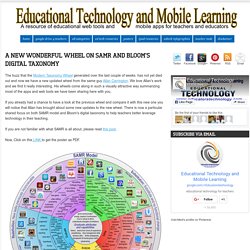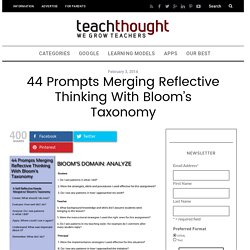

A New Wonderful Wheel on SAMR and Bloom's Digital Taxonomy. The buzz that the Modern Taxonomy Wheel generated over the last couple of weeks has not yet died out and now we have a new updated wheel from the same guy Allan Carrington.

We love Allan's work and we find it really interesting. His wheels come along in such a visually attractive way summarizing most of the apps and web tools we have been sharing here with you. If you already had a chance to have a look at the previous wheel and compare it with this new one you will notice that Allan has brought about some new updates to the new wheel. There is now a particular shared focus on both SAMR model and Bloom's digital taxonomy to help teachers better leverage technology in their teaching.
If you are not familiar with what SAMR is all about, please read this post. Now, Click on this LINK to get the poster as PDF. Bloom's Taxonomy Archives - TeachThought. MNPS Bloom's Digital Taxonomy - Home. Home. Anderson and Krathwohl - Bloom's Taxonomy Revised - The Second Principle. Understanding the New Version of Bloom’s Taxonomy ©Leslie Owen Wilson (2016, 2013, 2005, 2001) Contact Leslie A succinct discussion of the revisions to Bloom’s classic cognitive taxonomy by Anderson and Krathwohl and how to use them effectively Background: Who are Anderson and Krathwohl? These gentlemen are the primary authors of the revisions to what had become known as Bloom’s Taxonomy — an ordering of cognitive skills.
Here in the United States, from the late 1950s into the early 1970s, there were attempts to dissect and classify the varied domains of human learning – cognitive (knowing, or head), affective (emotions, feelings, or heart) and psychomotor (doing, or kinesthetic, tactile, haptic or hand/body). While all of the taxonomies above have been defined and used for many years, there came about at the beginning of the 21st century in a new version of the cognitive taxonomy, known commonly before as Bloom’s Taxonomy. The Cognitive Domain: Taxonomies of the Cognitive Domain Sources: 44 Prompts Merging Reflective Thinking With Bloom's Taxonomy. 44 Prompts Merging Reflective Thinking With Bloom’s Taxonomy by Peter Pappas It’s been four years since I first published my “Taxonomy of Reflection.”

My interest in reflective thinking is rooted in a simple but powerful statement by Donald Finkel who wrote that teaching should be thought of as “providing experience, provoking reflection.” (Teaching with Your Mouth Shut) Most school mission statements include a reference to “fostering life-long learners.” Unfortunately, self-reflection is rarely taught in school. I developed my Taxonomy of Reflection in an effort to provide a schema of prompts that could be used by students, teachers and administrators to hone their reflective skills.
Seen through Bloom, that’s the equivalent of “Remembering: Retrieving, recognizing, and recalling relevant knowledge from short- or long-term memory.” Below are 44 sample of higher order reflective prompts. 1. Student 2. 3. Teacher 4. 5. The EHang 184 Is A Human-Sized Drone Taking Off At CES. We’ve seen some pretty cool stuff on day 1 of CES 2016, but probably nothing more eye-catching than the EHang 184, a human-sized drone built by the Chinese UAV company EHang.

Yes you heard right — a giant autonomous drone that fits a human. It’s basically what you would expect to see if someone shrunk you down to the size of a LEGO and stuck you next to a DJI Inspire. Except no one was shrunk, and the giant flying machine was sitting smack in the middle of the CES drone section. EHang, which was founded in 2014 and has raised about $50M in venture funding to date, was pretty gung-ho about telling everyone at CES that the 184 was the future of personal transport.
And for the most part, people were too in awe to question them. But the reality is that the company probably was using the 184 as more of a marketing tool for their standard-sized drones like the Ghost. None of their employees were in tune with the drone’s technical specifications, let alone an MSRP or release date. How To Use Bloom’s Taxonomy To Write Learning Outcomes. By: Scott Davis Business Analyst, Pearson It is often quite difficult to relate inputs to outcomes in the world of education.

Traditionally, much work has been done to develop and provide inputs into the process of education. These inputs, such as a textbook, an assessment, a learning technology or platform, a course, a qualification, a high-stakes test or professional development for teachers are put into the hands of an educational leader, a skillful teacher, or an eager student. And, for all of the investment, expertise, and care that go into their creation, that has typically been where the involvement ends. Rarely has one been able to measure or predict the learning outcomes from using these inputs. If we are going to really understand how we might be impacting student learning we must do two things. It may be difficult to know where to start in writing a student learning outcome. The committee identified three domains of educational activities or learning (Bloom, 1956):
14 Bloom's Taxonomy Posters For Teachers. Blooms-wheel-power-verbs. BloomsTaxonomySized. Eoe BloomsTaxonomy. Blooms-verbs. Blooms unlv-online-education. Blooms-pinwheel. Blooms-lia.